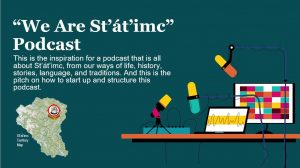A new BCIT partnership with the Lillooet Tribal Council brings culture — and laughter — into the classroom, and beyond.
“Try to bring it out with humour. Make them feel comfortable,” says St’át’imc Elder from Qaqy’ten/Sekwel’ and language teacher Linda Redan. “It drops that wall and they start to remember what they’ve heard from other people, what they’ve heard from other Elders or their grandparents, and it starts to come out.”
For the past few months, Linda has been sharing wisdom and humour with students — along with valuable lessons in tradition, storytelling and language — as part of a course created collaboratively by the Lillooet Tribal Council (LTC) and BCIT: Cultural Teaching (XCUL 1001).
“Every class started by lighting a candle. When students enter a classroom, students have tension,” observes Linda. “The flame takes away their tension and helps them to be calm so they can instill what the teacher is teaching.”
This helped foster an open and supportive learning environment.
“When the walls come down, and everyone is comfortable-you can see in their eyes that they are ready to learn,” Linda explains.
“The wall is the students’ apprehensiveness about a new a lesson, new people in the classroom — they build a wall because they don’t want to be hurt. The openness to receive is not there. They keep that closed off until they feel comfortable. That comfort comes from our way of using humour, storytelling, and Elders’ teachings. That takes the walls down and then we have fun.”
Linda is one of three course facilitators, including Lillooet language researcher Jen Narcisse-Joseph and teaching assistant Kitrina McDonald.
When Linda speaks, she moves from St̓át̓imcets to English seamlessly, weaving stories from her childhood in BC, like fishing for trout with her grandmother, with contemporary references like, “Léxlex Xétsem” for computer — or “smart box.”

The Cultural Teaching course is embedded in the first-ever Office Fundamentals microcredential program presented by BCIT this spring, in partnership with the Lillooet First Nation through the Lillooet Tribal Council.
It provides an opportunity to explore cultural teachings, language, and stories connected to the content of the microcredential, says the BCIT Business + Media course outline. It also emphasizes: “Humour with storytelling will be the primary mode of instilling the teachings.”
Ernest Armann, Program Manager for Indigenous Skills and Employment Training (ISET) and Chief Operations Officer for Lillooet Tribal Council wanted to create an academic partnership that supported things like nation-building work, as well as recognizing key learning outcomes.
“I wanted to do something different,” reflects Ernest, adding the idea for the new Office Fundamentals program and partnership project began to take shape after a positive meeting with BCIT.
From there, things came together quickly. Soon, Jen agreed to come onboard, says Ernest, as well as translator and transcriber, Linda, and language learner Kitrina — all helping develop, plan, and deliver the new course.
The Cultural Teaching component is woven through the new microcredential so participants learn ways to carry their St’át’imc ways of being and values into everyday life — from Microsoft Excel and PowerPoint, to learning how to use the St’át’imcets keyman keyboard for Windows programs.
Have you subscribed? Sign-up to receive the latest news on BCIT.
Language lifts the spirit

“It’s amazing that BCIT was not just open to including a component called Cultural Teaching, but also being open to how we were going to deliver the learning outcomes through stories,” points out Jen. “We are using our ways — our St’át’imc ways.”
This includes topics like understanding the difference between western and Indigenous worldviews, demonstrating an understanding of how ways of being forms cultural identity, as well as learning how to introduce oneself in the language and in a cultural way.
“Our language has strength behind it,” notes Kitrina. “It connects us to who we are, where we come from. When you start using it, you just see the spirits lifting.”
It’s been a profound experience for everyone involved, agrees Amy Fell, who leads the School of Business + Media Corporate Training at BCIT and is the Program Head for the Business Management Advanced Diploma program.
“The Cultural Teaching component is unique and an exciting way of bridging Indigenous and western world views,” says Amy. “Linda, Jen, and Kitrina generously shared their wisdom and taught me the power of bringing Indigenous ways of teaching and learning into the classroom. This offering enabled us to collaborate — truly collaborate. We both shared our wisdom and developed an offering that holistically supported participant skill development.”
Though the program was offered remotely, students created a real sense of community online with instructors and one another too, says BCIT instructor Eduardo Sanchez Martinez, who taught the office fundamentals coursework: “I just love hearing the students talk about what they’re learning.”
Linda observed this as well.
“Núk̓wantwaĺ. Help each other,” sums up Linda. “Núk̓wantwaĺ: That’s what’s happening in Eduardo’s class.”
Microcredentials are short, for-credit, modular programs or courses that help learners quickly master new skills and gain knowledge essential in in-demand Canadian industries. Explore BCIT microcredential courses.
(This story was written by Chantal Eustace.)
